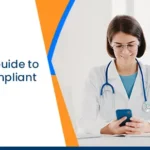What is an Incidental Disclosure Under the HIPAA Privacy Rule?

September 30, 2024
Table of Contents
- Introduction
- Understanding the HIPAA Privacy Rule
- What is an Incidental Disclosure?
- Conditions for Incidental Disclosures
- Examples of Incidental Disclosures
- Distinguishing Between Incidental and Unauthorized Disclosures
- Implementing Reasonable Safeguards
- How to Respond to an Incidental Disclosure
- The Importance of Regular Audits and Reviews
- Final Thoughts
In 2022, Optical Character Recognition (OCR) issued a record 707 penalties, the most since they gained the authority to enforce HIPAA compliance in 2006. Protecting personal health information has become more critical than ever, so it is crucial to understand the nuances of the HIPAA Privacy Rule. One specific area of concern is “incidental disclosures.”
Many people wonder what happens when their medical information is overheard at public clinics or shared spaces. This is when HIPAA comes into the picture.
In this blog, we will explain incidental disclosure under HIPAA, its implications under HIPAA, and how healthcare providers can manage them.
Understanding the HIPAA Privacy Rule
The Health Insurance Portability and Accountability Act (HIPAA) Privacy Rule establishes national standards to protect medical records and other personal health information (PHI). It applies to health plans, healthcare clearinghouses, and healthcare providers because they conduct certain healthcare transactions electronically.
The rule ensures that individual health information is well protected. It allows the flow of health information needed to provide high-quality healthcare and will also protect the public’s health and well-being.
What is an Incidental Disclosure?
What is incidental disclosure? Well, it’s an unintended/secondary disclosure of PHI. It takes place in the form of a by-product of an otherwise permitted or required disclosure. When all the minimum standards and safeguards are in place, these unintentional disclosures will not be viewed as a violation. Here are some of the conditions that are not displayed as violations under the HIPAA privacy rule:
- Pharmacy pick-ups
- Appointment reminders
- Patient charts
- Sign-in sheets
- Conversations within a clinical environment
Healthcare environments are inherently complex, making it nearly impossible to eliminate all risks of incidental disclosures. The HIPAA Privacy Rule acknowledges this by allowing certain incidental disclosures, provided they meet specific conditions.
Conditions for Incidental Disclosures
The incidental disclosures under the HIPAA rule are regarded as the unintentional divulgence of protected health information, which takes place in the form of a byproduct of permissible activities. All these revelations are not offenses only when all the right precautions are in place, and minimum measures are observed. However, for an incidental disclosure to be permissible under the HIPAA Privacy Rule, it must meet the following conditions:
-
Reasonable Safeguards:
The covered entity or business associate must have implemented reasonable safeguards to protect personal health information. These safeguards include administrative, technical, and physical measures designed to prevent the unauthorized use or disclosure of PHI.
-
Minimum Necessary Standard:
The disclosure must come from a permitted usage of health data. When the information gets shared, it must follow the privacy rule of HIPAA. This clearly means that the entity should share even a small amount of data to complete the work. Doing so will let the entity achieve its purpose and also get to guard the patient’s privacy.
-
By-Product of a Permissible Disclosure:
The incidental disclosure must occur as a by-product of a permissible or required disclosure under the HIPAA Privacy Rule. The primary disclosure should be permissible. If not, any incidental disclosure would also not be permissible.
Examples of Incidental Disclosures
Incidental disclosure takes place when the protected health information gets exposed unintentionally during the time of general healthcare activities. To understand this better, here are some incidental disclosure HIPAA examples that show where these disclosures might take place while following the HIPAA rules:
-
Overheard Conversations:
A healthcare provider consults a patient’s situation with another provider. Another patient/visitor unintentionally overhears the conversation. This is considered an incidental disclosure. However, this is acceptable under HIPAA if reasonable safeguards are in place. These safeguards are speaking quietly or using privacy curtains.
-
Sign-in Sheets:
In many healthcare settings, patients are required to sign in at the reception desk. Other patients may see the names of those who have signed in. This is an incidental disclosure. It’s allowed under HIPAA if the sign-in sheet does not include sensitive information. It will also be and if it is used to manage patient flow.
-
Calling Out Names:
A receptionist calls out a patient’s name in a waiting room. If other patients hear the name, it is an incidental disclosure. This practice is permissible under HIPAA. But it will be so as long as reasonable measures are taken to lessen additional disclosures.
-
Pharmacy Counters:
A pharmacist consults a patient’s medication at the pharmacy counter. If other customers nearby overhear the conversation, it’s deemed an incidental disclosure. Under HIPAA, the pharmacy can try to reduce the possibility of being overheard by using a quiet tone of voice.
Read More: When Does the State Privacy Law Supersede HIPAA?
Distinguishing Between Incidental and Unauthorized Disclosures
Incidental disclosures occur unintentionally in authorized uses or disclosures of Protected Health Information, whereas unauthorized disclosures violate the HIPAA Privacy Rule because the PHI is disclosed without authorization. The table below highlights the key distinctions:
| Criteria | Incidental Disclosures | Unauthorized Disclosures |
| Permissibility | Permissible under HIPAA if reasonable safeguards are in place and the disclosure results from a permissible use. | Not permissible under HIPAA and can lead to penalties and required notifications. |
| Conditions | Must occur as a result of a permissible or required disclosure and meet the minimum necessary standard. | No conditions allow for unauthorized disclosures; they violate HIPAA regulations. |
| Examples |
|
|
| Consequences | Generally, no penalties if safeguards are in place and the disclosure is incidental. | This may result in significant penalties, including fines and mandatory breach notifications. |
| Safeguard Requirements | Must have reasonable safeguards like physical barriers and secure communication methods. Another safeguard is training to prevent unauthorized access. | Safeguards are inadequate or not followed, leading to an unauthorized disclosure. |
| Documentation and Reporting | Incidental disclosures do not typically require breach notification. But, documentation and review are advised. | Unauthorized disclosures may need reporting. This is for affected individuals and HHS, along with potential legal consequences. |
| Impact on Patient Trust | Minimal impact if handled correctly with adequate safeguards and communication. | Significant negative impact, potentially damaging patient trust and the provider’s reputation. |
Implementing Reasonable Safeguards
When you implement proper safeguards, it will protect patient privacy and ensure compliance with the HIPAA rules. All these safeguards consist of both the physical and administrative measures that restrict entry to PHI. It also helps reduce the possibility of unauthorized disclosures. Below are some safeguards that will help healthcare organizations lessen the risk of privacy breaches and improve patient trust:
- Training Employees: This training will educate employees on HIPAA requirements and the importance of safeguarding PHI. It will also cover the best methods for managing PHI and reduce the danger of incidental disclosures.
- Physical Barriers: Use physical barriers, such as privacy screens or partitions, in areas where PHI is discussed or displayed. For example, in a shared clinic room, use curtains to separate patients. This will help prevent incidental disclosures.
- Technical Safeguards: Install technical safeguards like encryption and access controls to help protect electronic PHI. This ensures that only authorized personnel can access sensitive information and reduces the risk of unauthorized or incidental disclosures.
- Secure Communication: Use secure methods for communicating PHI, such as encrypted email or secure messaging platforms. Avoid discussing sensitive information in public areas where others may overhear the conversation.
- Limiting Access: Restrict access to areas where PHI is stored or discussed. For instance, patient records should be in locked cabinets, and access to electronic records should be limited to authorized personnel only.
- Signage and Notices: Post signs to remind employees and visitors about privacy and the need to protect PHI. Put the notices in waiting rooms, examination rooms, and staff-related areas. This will help support the significance of confidentiality.
How to Respond to an Incidental Disclosure
Having a proper understanding of how to respond to incidental disclosures is vital for preserving compliance with the HIPAA rules and protecting patient privacy. Incidental disclosures might take place accidentally during a normal routine, and knowing the steps that can mitigate the dangers will help greatly. Well-prepared responses will not just address the situation instantly but will also support the value of protecting health data in the future. Here are some steps to consider:
- Evaluate the Situation: Assess the nature of the disclosure and determine whether it meets the criteria for an incidental disclosure properly.
- Document the Incident: Record the details of the incidental disclosure, including the date, time, location, and individuals involved. This documentation can be valuable in demonstrating compliance with HIPAA requirements.
- Review Safeguards: Examine the safeguards in place at the time of the disclosure. After that, determine if they were adequate. If not, consider implementing additional measures to prevent similar incidents in the future.
- Employee Training:Training is vital for all employees to address incidental disclosures that might occur due to an employee’s actions. Offering extra guidance or training will prevent similar events from occurring in the future. This could include reminding staff of the importance of speaking softly in spaces and using secure communication methods.
- Patient Communication:Patients might be concerned about an incidental disclosure. Address their concerns and explain the safeguards in place to protect their privacy. Reassure patients that their privacy is a priority to maintain trust in the healthcare provider or organization.
Read More: Best HIPAA Compliance Software in 2024
The Importance of Regular Audits and Reviews
Periodic reviews and audits are essential for ensuring compliance with the HIPAA rules and protecting health data. By assessing all the practices and policies systematically, organizations can detect exposures. It will also help organizations improve security measures and maintain privacy protection and a culture of responsibility. Here’s why regular audits are required:
- Conducting Audits: Regular audits can help identify areas where PHI may be at risk of incidental disclosure. This includes reviewing physical spaces, communication practices, and employee behaviors.
- Reviewing Policies: Periodically review and update HIPAA policies and procedures to ensure they align with the latest regulatory requirements and best practices. This can help prevent outdated practices that may lead to incidental disclosures.
- Monitoring Compliance: Implement monitoring systems to track compliance with HIPAA safeguards. This can include surveillance cameras in areas where PHI is stored or discussed, as well as electronic monitoring of access to PHI.
- Addressing Gaps: If audits or reviews reveal gaps in compliance, take immediate action to address them. This may involve updating policies, retraining employees, or implementing new safeguards.
Final Thoughts
Incidental disclosure under HIPAA is an unavoidable aspect of healthcare environments, but the HIPAA Privacy Rule provides clear guidelines on how to manage them. Therefore, you must understand the incidental disclosure meaning what constitutes an incidental disclosure, and implement reasonable safeguards. This way, healthcare providers and organizations can protect patients’ privacy while ensuring compliance with HIPAA regulations.
Regular audits, employee training, and a commitment to privacy can further minimize the risk of incidental disclosure of HIPAA. It will also help maintain the trust of patients and the broader community.





